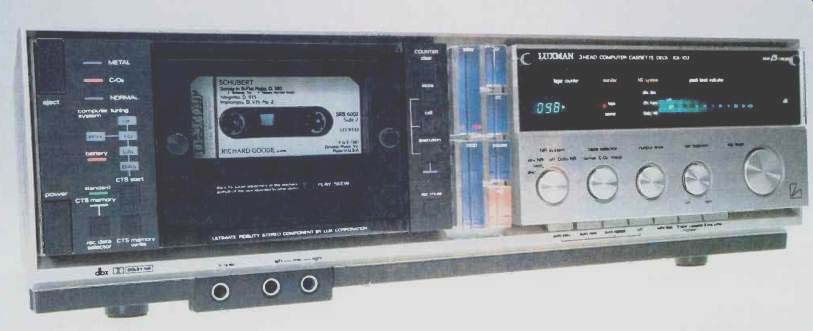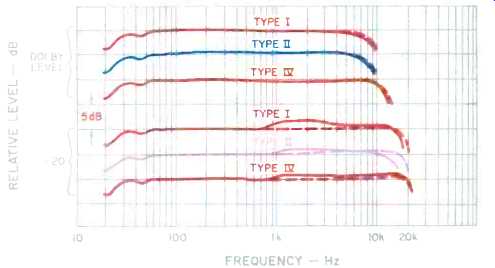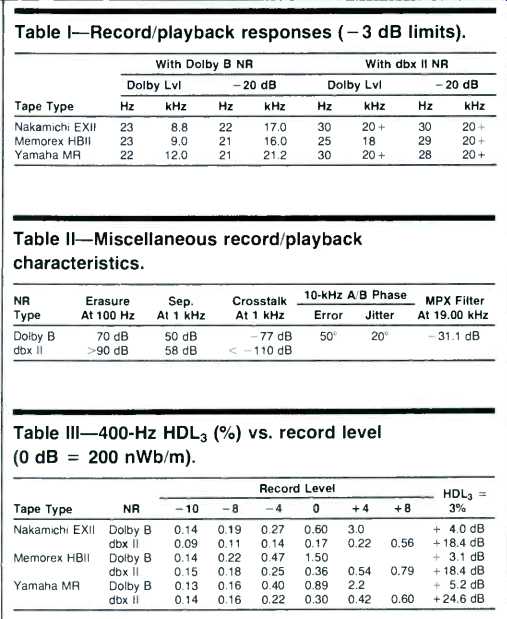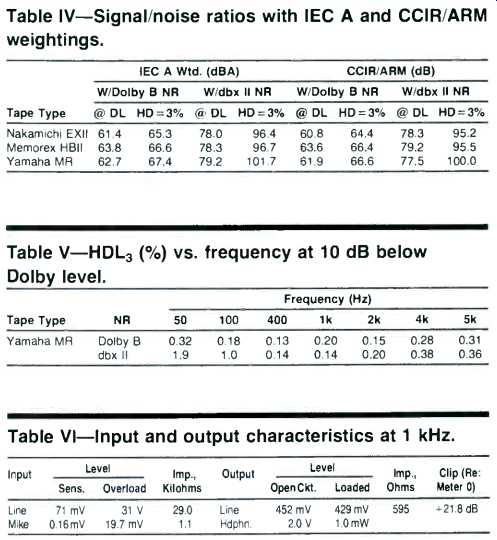
Manufacturer's Specifications
Frequency Response: 20 Hz to 18 kHz, to 20 kHz with metal tape.
Harmonic Distortion: 0.7%.
Signal/Noise Ratio: 61 dB, 68 dB with Dolby B NR, 94 dB with dbx NR (CCIR/ARM).
Input Sensitivity: Mike, 0.25 mV; line, 100 mV.
Output Level: Line, 500 mV; headphone, 1 mW (8 ohms).
Flutter: 0.04% wtd. rms.
Dimensions: 17.8 in. (453 mm) W x 5.8 in. (147 mm) H x 14.4 in. (365 mm) D.
Weight: 20.9 lbs. (9.5 kg).
Price: $999.95.
Company Address: Luxman Division of Alpine Electronics, 3102 Kashiwa St., Torrance, Calif. 90505, USA.
The KX-102 is Luxman's top stereo deck, featuring a Computer Tuning System (CTS) to match the deck's recording parameters to the specific tape in use, plus dbx and Dolby B noise reduction, and three heads.
At the left edge of the front panel are the "Power" and "Eject" buttons, plus the CTS controls. The clear compartment door swings out for drop-in tape loading, making it easy to see how solid the support bar for the combination mount record and playback heads is, and making the heads accessible for cleaning. Phone jacks for headphones and left and right microphones are below, inset a bit from the main panel.
Just to the right of the tape compartment is a vertical column of small light-touch buttons--one for "Rec Mute" and four for the counter and memory system: "Clear" resets the three-digit fluorescent display to "000," "Store" enters the counter reading into memory, "Call" displays the stored reading (even if the deck is in fast wind), and "Execution" (with a red status light) stops the deck at the stored reading in either wind direction.
To the right of these are the transport control buttons: Large, clear-plastic push bars with fairly small red indicators for "Play," "Pause," "Stop" and the two fast-wind directions.
Logic circuits allow switching from any mode to any other, including directly into recording from play, or even from fast wind.
The lower right panel area contains the knobs for NR selection, tape selection, "Output Level," "Rec Balance" and (larger) "Rec Level." This area uses Luxman's motorized Servo Face technology, a motor system which brings the front panel out flush with the front surfaces of the knobs when the power switch is turned off. When the power is turned on, the panel section moves back about 15 mm, making all knobs accessible for adjustment, and restoring full access to the row of seven small pushbuttons just below.
The rotary NR-selector switch has positions for "Off" and "Dolby NR" plus two positions for "dbx NR"-one each for "Tape" and "Disc." In the latter position, discs can be decoded with the KX-102 in stop, pause or wind modes.
There is also a very sensible interlock system which ensures that the deck will be in dbx tape mode during recording or playback, even if the switch is at "Disc." Small, reminder LEDs just to the left of the horizontal bar-graph meters show which NR mode has been selected.
Record levels are set with the large master "Rec Level" and smaller "Rec Balance" knobs, and monitored on a bright, fluorescent bar-graph meter (peak-responding, to facilitate accurate level setting). The display panel also includes the electronic tape counter and LEDs indicating whether the deck's monitor switch is in "Tape" or "Source" position.
The monitor switch is one of seven buttons at the bottom of the panel. The others are: "MPX Filter" (on/off), "Line/Mic" input select, and four for auto transport functions ("Auto Play," "Auto Rew," "Auto Repeat" and "Off"). With the "Execution" switch turned off, these functions are fairly self-explanatory. "Auto Play" puts the deck into play mode as soon as the tape is rewound; "Auto Rew" does the opposite, rewinding the tape once play is completed, while "Auto Repeat" cycles continuously through both.
With the "Execution" mode on, the possibilities grow more elaborate. With only the "000" point in memory, all functions act as if that point were an end of the tape, running only up to that point or from that point to the end, depending on where you start. If you have also stored another location in the memory, the functions will treat both memorized points as start/end points. (This lets you endlessly repeat one passage on the tape, if you desire.) This is just a summary, of course-the full-page diagram in the owner's manual shows 43 different possibilities! The Computer Tuning System, by contrast, is pretty much a straight pushbutton process. Once a tape has been loaded, and the "Tape Selector" on the Servo Face panel has been set (to " Normal," "CrO2" or "Metal"), a push of "CTS Start" initiates the automatic process. A series of illuminated blocks show exactly what is being done: " Cal" first, then "Bias," back to " Cal," and then back and forth between " Cal" and "EQ." If the adjustments yield a response within the built-in criteria, "OK" is illuminated, and the tape is wound back to the calibration start point. Then, the information can be entered into memory by a push of "CTS Memory Write." There is one user-set memory position for each tape type; each insertion erases any previously stored data from that memory. If the tape does not meet the adjustment criteria (for example, if the tape selector is in the wrong position), CTS will do its best, but the "Error" block will light.
A "Rec Data Selector" button chooses either "CTS Memory" or "Standard," the latter providing fixed bias and EQ to match common tapes of each type.
A red LED bar indicates battery status. If it is on, the battery voltage is high enough to maintain data in memory with the recorder off, while a blinking display tells the user that the batteries should be replaced. Above this group of indicators and switches are three LED bars that show which tape type has been selected.
The back panel has the expected line in/out phono jacks, plus a jack for an optional remote control and the battery compartment for the CTS memory system. There is also a phono jack for interconnection with a Luxman turntable, to use their auto-disc pause for initiating recording when the arm sets down.
With the removal of the heavy steel side and top cover, I could see the high-quality components contained. A large p.c. board was almost full chassis size, and it also served as the mother board for two good-sized vertical boards, which were well-supported and braced. All of the parts were identified, with many adjustment pots in evidence. The soldering was excellent, and interconnections were with multi pin cabling. Worthy of note were the rigid drive assembly and the large, shielded transformer. The control-panel drive/ cam system worked smoothly, and it was certainly well made, but I did wonder about its value to most users.
Measurements
The playback responses with standard alignment tapes were well within ±2 dB for both 70- and 120-uS equalizations, except for the 120-uS low-end point and the 70-uS high-end point. The playback level indications were correct, within the resolution of the meter segments. Tape play speed was 1.6% high, more of a deviation than measured on most decks in any price category. Checks of the KX102's responses using the built-in "Standard" tape settings indicated that the deck parameters did not match the IEC reference tapes as closely as they did some of the hotter tapes (Sony UCX-S, TDK SA-X, etc.). The CTS system was evaluated with a wide range of tapes, and responses were also checked using dbx and Dolby NR. CTS usually took less than 20 S, sometimes less than 10, but a couple of tapes required about 45 S. As a generality, all of the responses with dbx NR and without NR were very flat. With Dolby B NR, however, most tapes had some high-end roll off and a boost around 2 kHz.

Fig. 1--Frequency responses with (solid lines) and without (dashed lines)
Dolby B NR, using Nakamichi EXIT (Type I), Memorex HBII (Type II) and Yamaha
MR (Type IV) tapes.

Fig. 2--Record/playback responses to pink noise, using dbx II NR, at Dolby
level (top traces) and at-20 dB, for Nakamichi EXIT, Memorex HBII and Yamaha
MR tapes (top to bottom in each set). Vertical scale: 5 dB/div.
The tapes showing the least of such deviations were Nakamichi EXIT, Memorex HBII and Yamaha MR, which were used for the remainder of the tests. Other tapes, substantially as good with the KX-102, were Fuji FR-I and FR Metal, Loran High Bias, Maxell XL I-S, Nakamichi ZX, TDK SA-X and MA and Yamaha CR-X. The record/playback swept-frequency responses with and without Dolby B NR are shown in Fig. 1, and the responses with dbx NR and pink noise are shown in Fig. 2.
(The responses with dbx II NR cannot be measured correctly with a sweeping sinusoidal signal.) All of the responses are very flat, particularly between 60 Hz and 13 kHz or more at-20 dB. There is some evidence of boost at 2 kHz (Type I) and high-end roll-off (Type II), but these deviations are moderate. The 3-dB down points with the two NR systems are listed in Table I. The exact high-end limits could not be determined for dbx NR with the pink-noise/RTA combination, but they did appear to be at least 20 kHz in most cases. The 25 to 30 Hz low-end limit appeared to be a limitation of dbx NR, as the Dolby NR results were notably closer to the 20-Hz specification.
The results from measuring a number of record/playback properties are listed in Table II. In general, the figures are excellent: Note in particular that dbx II NR decoding improved the effective erasure and crosstalk greatly. The 10 kHz phase jitter was fairly low, but the interchannel error was just average.
The level of third-harmonic distortion was measured for the three tapes, with both NR systems, from 10 dB below Dolby level to the points where HDL3=3%. Table Ill shows clearly that although the level of distortion was close for all combinations at-10 dB, there were increasing differences between NR-system results above the lower limit. An associated test check indicated that the dbx unity-gain level (no compression in encoding and no expansion in decoding) was at-10 dB. Thus, it was not surprising to see that the distortion was obviously lower for dbx NR at the zero level.
The continuing benefit of the compression lowering the distortion led to very high 3% points, substantially at the output-level limits of the deck. With such high record-level limits, it doesn't seem so surprising to find the very high signal-to-noise ratios listed for dbx II NR in Table IV. Those for Dolby B NR are quite good, even though they seem a bit gentle in comparison.
HDL3 was measured for both Dolby B NR and dbx II NR at 10 dB below Dolby level from 50 Hz to 5 kHz. In this comparison, we can see that there was fairly low distortion in either case from 400 Hz up, but that with Dolby B NR it was less below 400 Hz, significantly at 50 and 100 Hz.
The results from measuring input and output characteristics are shown in Table VI. Most of the entries are equal to or better than the specifications, although the line output level was slightly low. The two sections of the input-level pot tracked within 1 dB for 55 dB down from maximum, which is excellent. The output-level pot sections tracked within 1 dB for about 40 dB-fairly good and quite acceptable for this function. The output polarity matched that of the input, both in "Source" and in "Tape." The bar-graph level meters responded fully to bursts as short as 10 mS, and were just 3 dB down with a 3-mS burst, meeting criteria for peak responding meters. The meter decay time of 150 mS was actually on the short side, as 1.4 to 2.0 S is preferred. The frequency response of the meters was 3 dB down at 17.8 Hz (just fine) and 75.9 kHz (unnecessarily high). The scale calibrations were excellent, with all thresholds from "-20" to "+8" within 0.3 dB. The display was very bright and easy to read under a wide range of lighting levels.
Flutter was consistent throughout a C-90, with excellent figures of 0.035% wtd. rms and 0.057% wtd. peak. The tape play speed appeared to be quite constant with changes in line voltage, but variations in speed with time-amounting to a total spread of 0.1% (just fair)-confused the assessment.
The wind time for a C-60 cassette was 88 S, longer than most decks.

Table I-Record/playback responses (-3 dB limits).
Table II-Miscellaneous record/playback characteristics.
Table III-400-Hz HDL3 (%) vs. record level (0 dB = 200 nWb/m).

Table IV-Signal/noise ratios with IEC A and CCIR/ARM weightings.
Table V-HDL3 (%) vs. frequency at 10 dB below Dolby level.
Table VI-Input and output characteristics at 1 kHz.
Use and Listening Tests
The owner's manual gets across most of the basic information, but there should be more information on the noise reduction systems and setting record levels. The discussion on CTS is good, and there is a helpful illustration on the auto-function wind/play modes. Loading was simple (just drop in), and maintenance on the heads and tape path was easy, particularly with the door cover removed. All controls and switches were completely reliable, with no malfunctions noted. I did notice that after some time of use, the cassette shell felt quite warm on removal, but no detrimental effects were found.
CTS did its calibration quite consistently: The differences from one time to the next were not detectable by ear. I did try to fool the system by trying to calibrate TDK D in the metal tape position and to do Yamaha MR in the normal position. Sometimes I got away with it, and sometimes I got "Error." My conclusion is that the user should not rely on CTS to point out bad choices: Make certain that the tape selector is set correctly.
The transparent transport-control buttons looked good, but gave me a slight problem: Unless I looked at them straight on, I could not always tell which button was illuminated. On the other hand, I liked the recording level-control setup, with its "Rec Master" control (for overall level) and "Rec Balance" (for relative level between channels) slightly better than the usual individual-channel controls or the combination of individual-channel pots plus a master.
Levels were easily set with the peak-responding meters, but a slower decay time would have been helpful. Listening tests utilized pink noise as well as the normal collection of selected discs. There really seemed to be a sweeter sound with Dolby B NR, even at fairly high levels, compared to operation without noise reduction. The general character was very close, with Dolby B NR perhaps slightly brighter.
Recording at purposely high levels and switching back and forth showed, immediately and emphatically, how much distortion dbx II NR prevents under such high-level conditions. Record, pause and stop sounds were all very low, even with Dolby B NR. The Luxman KX-102 has responses that are very flat where it counts the most, low flutter and excellent signal-to-noise ratios, especially with dbx II NR. Its CTS system does a consistent and excellent job of adjusting bias, record sensitivity and EQ, but particular tape choices may best ensure the maximum performance from Dolby B NR. The deck has quality parts and solid construction, indicators of future reliability. The Servo Face front panel did not seem that beneficial to me; I would have traded it for more accurate play speed. The potential user would be advised to concentrate on its performance features when comparing the KX-102 to other decks in its price range.
-Howard A. Roberson
(adapted from: Audio magazine, Mar. 1984)
= = = =
Also see:
Nakamichi CR-7A Cassette Deck (Aug. 1986)
Harman/Kardon CD491 Cassette Deck (Equip. Profile, Mar. 1984)